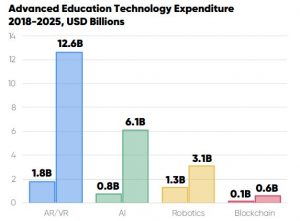Global Artificial Intelligence Boom Predicted in Education, Particularly in China
Artificial intelligence is one of the fastest-growing areas of technology in the global education market, according to a new report from a market intelligence firm.
The report, from market research firm HolonIQ, examines the evolution of AI from K-12 through higher education and into adult professional and corporate learning. To do its analysis HolonIQ created a platform that identifies 60,000 education organizations and companies, then tracked more than 400 companies around the world that have AI at the core of their business, said company co-founder Maria Spies.
In 2018, just under a billion dollars worldwide was spent on AI in education, Spies said, and that number is expected to grow to over $6 billion by 2025. Spies said it can be difficult to identify which companies are actually using artificial intelligence to power their products, because the technology is currently defined in so many different ways.
“Every company you come across these days says they use artificial intelligence, but some of them don’t,” she said. “It’s still a fuzzy term.”
The report noted five core areas where AI technology is being developed and used for education:
- Vision—Emotion recognition is used to detect confusion and engagement, with identity management applications for testing and virtual learning.
- Voice—Text-to-voice interfaces are utilized to support learning activities, particularly literacy and language learning.
- Natural Language—Deciphering human language is a complex AI challenge. However, this technique is emerging in assessment, feedback, and plagiarism detection.
- Algorithms—This “machine learning” is being applied to create personalized, adaptive learning paths for students.
- Hardware—Smart devices, robotics, laboratory technology, and software systems are all being powered by AI.
 Recent advances in AI technology are being used more frequently in the learning process itself, the report notes, particularly in language education, assessment, and gesture recognition in online classrooms.
Recent advances in AI technology are being used more frequently in the learning process itself, the report notes, particularly in language education, assessment, and gesture recognition in online classrooms.
China Aims for the Lead
China and the U.S. will account for 60 percent of the global AI education spend, the report notes.
While the U.S. market has a strong research base around artificial intelligence, China is less regulated and there are fewer privacy concerns, making that market ripe for expansion, Spies said.
“There’s growth in investment and around research activity in artificial intelligence,” she said. “China is investing a lot of money as part of a national strategy. They aim to be the leader in artificial intelligence.”
Most of the venture capital investment in the K-12 space in China is in the after-school market, which includes online tutoring and test prep, she noted. “A lot of that lends itself to AI,” she said.
But the application of artificial intelligence in education differs by country and region. In South America, for example, the report found that artificial intelligence technology is used mostly in English language learning, as students and adult learners interact with “chatbots” to practice and build their language skills. However, applications of AI technology to standard K-12 curricula are “fairly small around the world,” Spies said.
Notably, research on AI globally also differs in its focus. AI papers in China tend to focus on engineering, technology, and agricultural sciences, while AI papers in the U.S. and Europe focus on humanities and medical and health sciences. In addition, the report found that more papers are being published on AI worldwide than those on computer science, suggesting a greater interest in the topic.
Six Areas to Watch
The report notes six areas where AI is creating value in education:
1. Learning processes: This area covers intelligent classrooms, adaptive and personalized content for students, robotics, and language learning with virtual tutors.
2. Assessment and feedback: AI is automating and personalizing assessments, giving feedback on written work, and helping students plan assessment tasks.
3. Learner/talent acquisitions: Organizations and institutions are using AI technology to find and retain students and employees. Universities are using it in admissions to match applicants with requirements, using chatbots to answer student questions, and organizations are using the technology to better hire professional employees and find talent.
4. Administration/business processes: AI technologies are helping to ease the burden of administrative processes and grapple with the massive amounts of data that schools and districts collect. AI is helping to identify and predict risks, automating services, and streamlining administrative tasks.
5. Language learning: AI is assessing students’ current knowledge and learning capabilities, delivering adaptive content based on learning patterns and providing feedback using speech-recognition technology.
6. Corporate training: AI is “set to revolutionize corporate training” the report finds, with personalized, adaptive supports and real-time monitoring of daily workflow to close gaps between training and performance.
Spies also said she expects to see some of the geographic boundaries around development and research of AI products blur.
“This is a global future. It’s not bounded by geography because it’s all based online,” she said. A U.K. learning app which taps AI technology can have lots of customers in other world markets, for example, she said.
However, AI technology is still not mainstream in education. Though its use is on the rise, “and there’s a lot of activity,” Spies said. “It hasn’t broken through in the general consciousness yet.”
Follow EdWeek Market Brief on Twitter @EdMarketBrief or connect with us on LinkedIn.
See also:

Very informative article, AI is making it easier to find what you didn’t even know the name of. Thank you for sharing